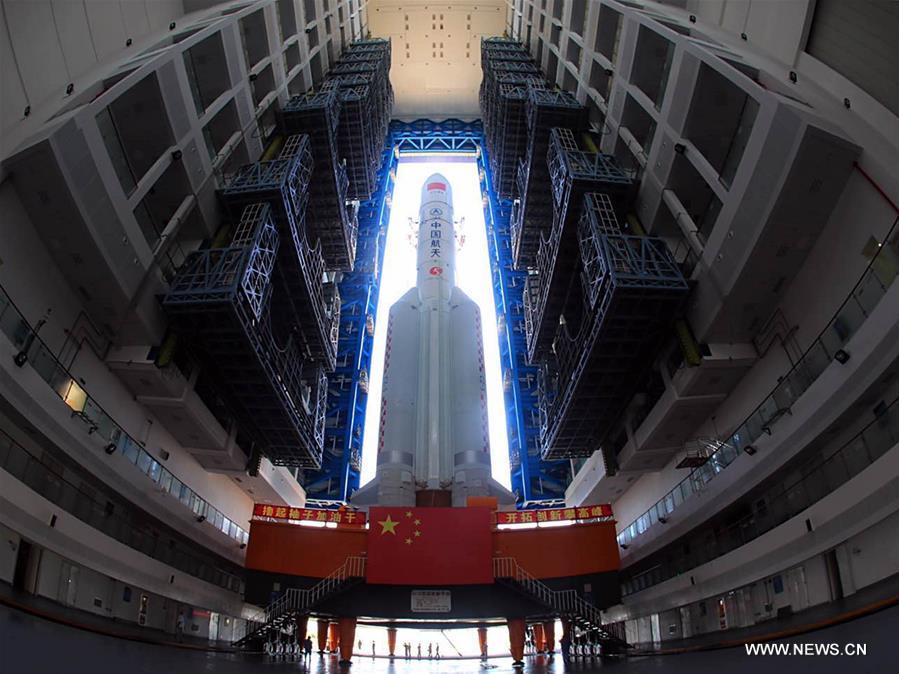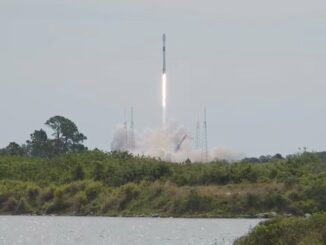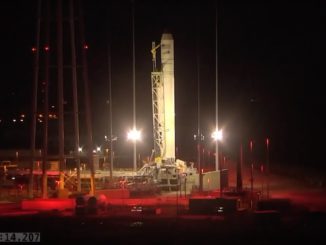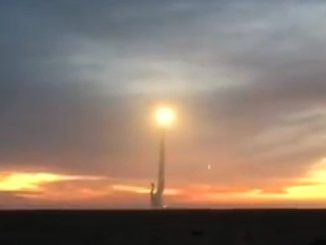
China’s Long March 5 rocket is counting down to liftoff Sunday from the country’s tropical island space center with a high-power, electrically-propelled communications satellite.
The heavy-lifter is scheduled to blast off from the Wenchang launch base on Hainan Island at around 1120 GMT (7:20 a.m. EDT; 7:20 p.m. Beijing time) Sunday, heading for an elliptical geostationary transfer orbit with the Shijian 18 communications satellite, the first in a new series of modern Chinese high-capacity relay stations.
Sunday’s launch will be the second flight of a Long March 5 rocket, China’s most powerful launcher, which made a successful maiden mission in November 2016.
Chinese space officials will closely watch the performance of the Long March 5 rocket Sunday as engineers prepare to send China’s Chang’e 5 sample return mission to the moon in November on the third launch of the heavy-lifter.
Ten engines on the Long March 5’s first stage and four strap-on boosters will send the launcher skyward on 2.4 million pounds of thrust. The 187-foot-tall (57-meter) Long March 5 will head east from the Hainan Island launch base, which will host its fourth launch Sunday after entering service last year.
Ground crews at Wenchang rolled the Long March 5 to its launch pad Monday.
Riding on a vertical launch table, the Long March 5 completed the trip in about two-and-a-half hours, according to the China Academy of Launch Vehicle Technology. Swing arms on the seaside launch pad’s 300-foot-tall (92-meter) service gantry enclosed the Long March 5 for final launch preparations.
China’s state-run media has not said if they plan any live coverage of the launch.
The Long March 5’s maiden test flight last year deployed an experimental satellite named Shijian 17 to test electric thrusters, technology that could give Chinese spacecraft improved maneuverability between different types of orbits around Earth.
The Shijian 18 satellite aboard Sunday’s flight is the first in an upgraded series of Chinese spacecraft called the DFH-5 platform. Developed by the China Academy of Space Technology, the DFH-5 design is bigger and more capable than China’s existing satellites, providing more power for communications payloads and additional data throughput for Internet providers, television broadcasters and data networks.
Shijian 18 also hosts a laser communications instrument for even higher-speed data links, and ion thrusters will keep the spacecraft in geostationary orbit, a perch more than 22,000 miles (nearly 36,000 kilometers) over the equator.
China hopes to sell communications satellites based on the new DFH-5 design to international governments and commercial customers.
Ground controllers will run the Shijian 18 satellite through extensive testing to verify the new satellite design works as expected.
Chinese officials say the Long March 5 is a centerpiece of the country’s long-term space ambitions, allowing China to dispatch satellites to space that are twice as heavy as payloads that can fit on earlier Long March rockets.
The heavy-duty rocket can haul about the same amount of weight into space as United Launch Alliance’s Delta 4-Heavy, the world’s other leader in space lift capability. The Long March 5 bests the capacity of the European Ariane 5 and Russian Proton launchers.
The Long March 5 is one of three new launch vehicles China has debuted in the last two years.
The Long March 6 is the smallest of the three, tailored to deliver small satellites into low-altitude orbits. The medium-lift Long March 7 is designed to carry resupply ships, and eventually crews, to China’s future space station.
The Long March 5 will haul three 20-ton modules to low Earth orbit for the Chinese space station, beginning next year with the launch of the Tianhe 1 core module. The Long March 5 is also slated to launch the robotic Chang’e 5 mission to the moon later this year to scoop up surface samples for return to Earth, and China’s first Mars rover will ride a Long March 5 rocket when it blasts off in mid-2020.
The new family of launchers will eventually replace China’s Long March 2, 3 and 4 rockets, which burn toxic liquid propellants and launch from inland space centers, requiring them to drop spent stages on land.
The Long March 5 rocket, when flown from Wenchang, jettisons its boosters over the South China Sea. Its engines also consume a more environmentally-friendly mixture of liquid oxygen, liquid hydrogen and kerosene.
Email the author.
Follow Stephen Clark on Twitter: @StephenClark1.



